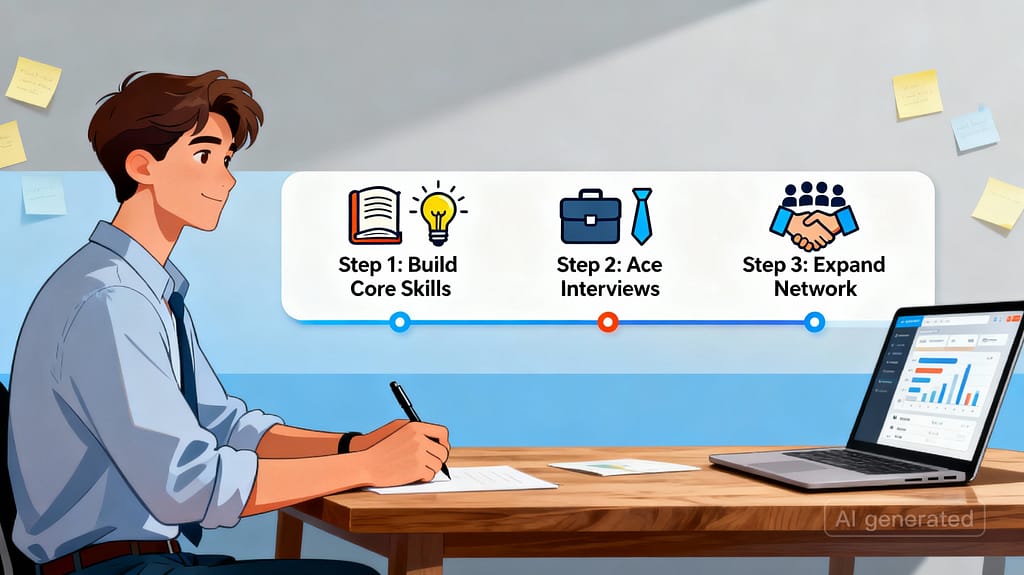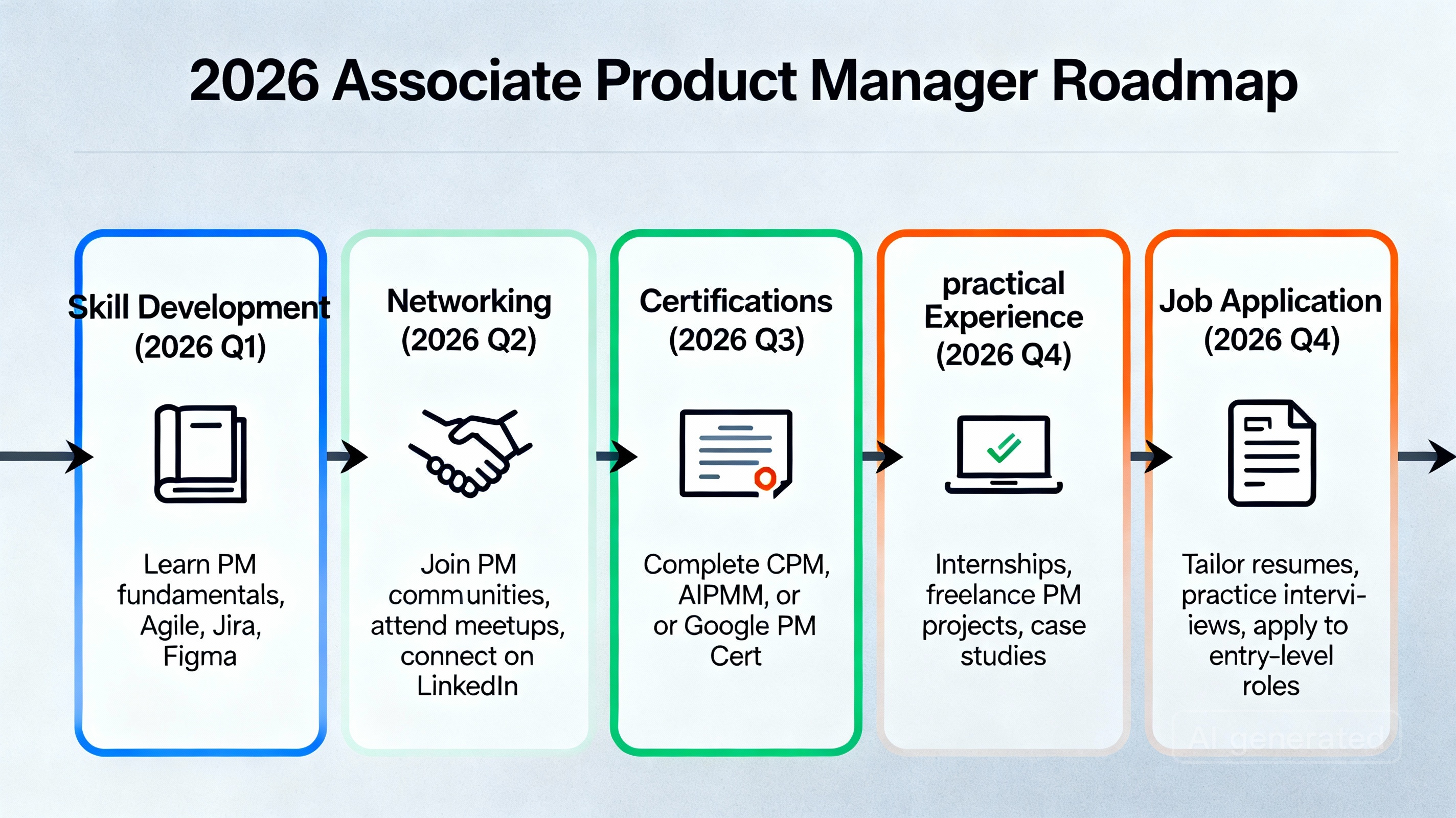If you’re aiming to step into the world of product management as an Associate Product Manager (APM) in 2026, buckle up. This isn’t a tutorial for beginners who want to wait for things to happen; it’s a strategic roadmap for someone who actively wants to make it happen.
Table of Contents
I’ll map out the steps, highlight what really matters (so you don’t waste time), point out common pitfalls (yes — you’ll have to face some of your own assumptions), and provide concrete actions. Since you already have a product-management interest, I’ll tie in how you can leverage your background, learnings, and also where you’ll need to fill gaps.

Why the APM role still makes sense (and what it is)
What an APM does?
- The APM role sits as an entry-to-early-career position in the product management career ladder. You typically work under more senior product managers, assist with product lifecycle tasks, and gain exposure. ProductPlan+2Product HQ+2
- Typical responsibilities include gathering user/customer feedback, analyzing data/trends, helping define feature improvements, working cross-functionally (design, engineering, marketing) and gradually owning small features or sub-areas of a product. Product School+1
- The role is not full ownership of a product end-to-end (that’s a Product Manager’s job). So you’ll still be in the “learning + supporting” zone. GeeksforGeeks+1
Why this role is useful for you
- Since you’ve already experienced product automation (you’ve built LMS, HRMS, automation work) you have some tech + product exposure. That’s a strength.
- As someone who wants to build a PM career, entering as APM gives you the chance to get mentored, scaffold skills, and then move into a full PM role.
- Because you’ve had communication/technical issues in prior roles (you told me), you can use this period to build those skills in a lower-risk environment (where you’re not yet fully owning everything) and demonstrate improvement.
Key Skills & Knowledge for the 2026 APM candidate
Here are the hard & soft skills you’ll need—and the ones you likely should prioritise given your background.
Hard / technical skills
- Data analysis: you should be comfortable interpreting metrics, trends, using tools like analytics dashboards, interpreting user behaviour. Institute of Product Leadership
- Technical understanding: You don’t need to code full-time (unless it’s a technical product), but you must be able to understand what engineering/design teams are doing, ask the right questions. GeeksforGeeks+1
- Product lifecycle knowledge & frameworks: You’ll need to know how a product moves from idea → validation → build → launch → iteration. Knowledge of agile (Scrum/Kanban) helps. Institute of Product Leadership+1
- Tool familiarity: Tools like Jira, Trello, analytics dashboards, prototyping tools (Figma, etc) will give you credibility. CareerFoundry
Soft/interpersonal skills
- Communication: Given your prior communication weaknesses, this is a major area. You’ll need to clearly convey product decisions, talk to stakeholders, summarise complex issues. Many APM roles expect good communication. Product School+1
- Curiosity + empathy: Wanting to dig into user needs, market problems, and being able to empathise with users is important. GeeksforGeeks
- Adaptability & teamwork: Products change, priorities shift. An APM needs to manage ambiguity and work with different teams. The CPO Club
- Problem-solving and initiative: You’ll be expected to spot where the product could improve and propose solutions (even if you are not owning the full roadmap). Institute of Product Leadership
Concrete Roadmap for You — 2026 APM Path

Here’s a step-by-step plan (with your background in mind) to position yourself for an APM role in 2026.
Step 1: Clarify your baseline & gap
- You have built automation systems (LMS, HRMS) → that’s good. Document those projects: the scope, your role, impact (metrics if available).
- Identify where your communication and technical issues previously flagged: e.g., did you struggle in stakeholder communication? did you struggle understanding engineering trade-offs? Be specific.
- Assess which APM skills you already have vs which you must build (refer to the list above).
Step 2: Build/expand your relevant experience
Since you want to be an APM, you’ll need practical product-adjacent experience. Given your background, here’s what you can do:
- Lead a “mini-product” or feature: For instance, volunteer in a startup (or internal project) to take a small sub-feature from concept → launch. Show you managed requirements, collaborated with design & engineering, tracked metrics.
- Use your automation/AI background: Position yourself as someone who brings AI/automation fluency and product fundamentals. That’s a differentiator. For example, focus on “AI automation in HRMS” as a product use-case.
- Fill any gaps: If you have weak exposure to user research or market analysis, pick up a side project or internship where you do user interviews, competitor research, etc.
Step 3: Upskill & certify (meaningfully)
- Since you already have a CSPO certificate, you have agile credentials. Good. Add product-specific certifications: The Certified Associate Product Manager (CAPM) or other product management certifications will help. Institute of Product Leadership
- Learn tools: Pick up one prototyping tool (Figma), one analytics tool, one backlog management tool (Jira/Asana).
- Study frameworks & best practices: Read “Inspired” by Marty Cagan, “Lean Startup”, practice product sense. You’ll need to talk product-sense in interviews (see next step).
Step 4: Build your narrative & interview readiness
- Craft a resume/story that emphasises product mindset: You built systems not just for building’s sake—but for improving workflows, for users, with measurable outcomes.
- Prepare for typical APM interview questions: e.g., “How would you prioritise features?”, “Tell me about a time you gathered user feedback and changed a product decision.” You’ll need to show you understand both technical and user-/business-side.
- Network: Connect with PMs in companies you like; attend product-meetups; ask for informational interviews. Hiring often involves both credentials and whom you know.
- Target companies/startups that have APM or early-career PM tracks. Some large tech firms have formal APM programmes. Google+1
Step 5: Apply + execute + learn
- Apply for roles labelled “Associate Product Manager”, “Junior Product Manager”, “Product Analyst → PM track”, etc.
- Once you land a role, treat it as a learning opportunity: set clear goals for yourself (e.g., own feature scope, improve metrics X by Y, lead cross-functional meetings successfully).
- Regularly reflect: What went well? What didn’t? Where did you get stuck? This reflection will pay off more than the title alone.
Specific Tailored Advice for You (yes, you)
- Since your communication has been a weak spot: Work on structured communication. For example, for every meeting/decision: prepare the “why”, “what”, “next steps”. Use visual aids (slides or diagrams) to clarify.
- Since you’ve been fired/left roles due to technical/communication issues: Use that as a narrative “I had gaps, I addressed them by X, I’m now equipped to add value” rather than pretend it didn’t happen. Authenticity + demonstration of growth will work in your favour.
- Use your AI automation angle: Many companies will value someone who understands automation/AI plus PM fundamentals. Especially as product management moves toward data-driven and AI-enabled products. Frame yourself as a candidate with domain fluency + product mindset.
- Set a timeline to prepare: For example, by Q1 2026 you’ll have completed a capstone side project; by Q2 you’ll have applied to X number of roles; by Q3 you’ll have gone through Y interviews. Use concrete milestones.
- Mind your clutter/habits: You mentioned you abandon goals, waste time, brain fog. For your PM career you’ll need consistency. Treat your learning path like a mini product with metrics (hours per week, project completion) and iterate. That discipline will show up in your story.
Pitfalls & What to Avoid
- Don’t wait for the “perfect background” (e.g., “I must have 5 years in PM”). Entry-level APM is about potential, not perfection. joinleland.com
- Don’t over-focus on title; focus on what you delivered. A job title means less than what you achieved.
- Don’t ignore business metrics: PM roles are business + customer + tech. If you only know tech, you’ll struggle in interviews.
- Don’t gloss over your communication weakness. Recruiters will test you on communication because PM is heavily cross-functional.
- Avoid generic applications. APM roles often favour candidates who show product thinking specific to the company’s domain.
Summary Checklist for 2026
| Milestone | Status | Next Action |
|---|---|---|
| Document past product/automation experience | ✅ | Translate into “impact statements” for resume |
| Identify & fill skill gaps (e.g., user research, analytics) | 🔲 | Select one side-project to own by Q1 2026 |
| Earn or plan a product-management certification | 🔲 | Enrol in CAPM / equivalent by end of year |
| Build network & apply for roles | 🔲 | Set target: connect with 10 PMs, attend 2 events in next 3 months |
| Prepare interview story & practice frameworks | 🔲 | Pick 5 common APM interview questions, rehearse weekly |
Ready to accelerate your product management journey? Explore more actionable insights, detailed guides, and career resources on my website, shubhamnayak.com. Every step you take towards becoming an APM sets the stage for lasting impact—let’s keep building your product story together.